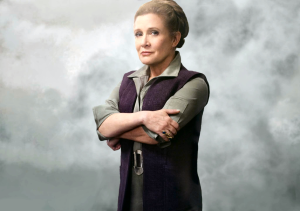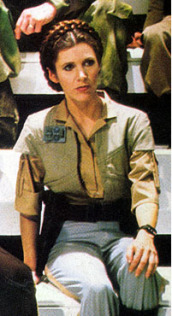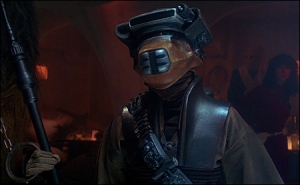
Leia Organa, the politician and revolutionary who led the defeat of the Galactic Empire, died after a short illness. She was 60 years old. Hers was a life laced with controversy concerning everything from her tactics to her very ancestry, but her intelligence, commitment to the Republican cause, and place at the heart of the Rebellion, and later the Resistance against Neo-Imperialism, remains the indisputable core of her legacy.
Early Life in the Rebellion
Organa was born Leia Amidala Skywalker, and the name presaged the uncertainty with which she would be viewed, even before her parentage became a matter of public record. Her mother, Padme Amidala, organized the Delegation of 2000 which resisted the foundation of the Palpatinian New Order, yet her father, Anakin Skywalker, would become better known as the Imperial war criminal, Darth Vader. Leia’s twin brother Luke Skywalker would be separated from her and taught the Jedi legacy by members of its hidden diaspora, but Leia was adopted by Delegation of 2000’s Senator of Alderaan, Bail Organa, who never told her about her true ancestry.
Yet he freely shared other secrets, including the networks, irregular forces and war materiel he and other anti-Imperial leaders organized to resist the New Order. By her early teens, Leia Organa demonstrated talents ranging from logistics to sapient asset intelligence analysis. Even as she helped him build the nascent Alliance to Restore the Republic, she found herself drawn to a different aspect of the broad front’s efforts. Her critical materialist analysis of the Rebellion drew from Gererrist radical pragmatism and (not knowing the author was her biological mother) Amidala’s Interspecies Discourse on Naboo, a text banned throughout the Empire due to COMPNOR’s human supremacist policies.
While Leia Organa’s letters, doctrines and later, command directives formed the ideological-strategic core of the Alliance, she avoided the leadership roles assumed by her father and Mon Mothma. Indeed, she used the courtesy title Princess (afforded by her adopted parents, as elected officials in Alderaan’s post-monarchic democracy) sparingly, and purely for political effect. She became a field operative instead, managing diverse intelligence assets under the cover of diplomatic and sapient-relief travel. Before the Battle of Scarif, her missions shared intelligence with numerous Alliance cells. Her uncanny ability to predict the actions of enemies and allies alike made her essential, but the Alliance treated her warily, concerned she might manipulate its forces for her own ends.

These worries may have been justified when Organa prevented Yavin IV Flight Command from properly securing arms and spacecraft related to the extraction of Jyn Erso. She correctly predicted Erso and the Andor faction would act on their own, and made a shuttle, droid and weapons conveniently available. Operation Rogue One remains controversial; critics note that Organa sacrificed the entire volunteer cadre, hundreds of troops and much of the Alliance fleet to acquire Designation Stardust intelligence, and that its ultimate success owed itself to her activation of a Jedi asset, Obi-Wan Kenobi, as she was captured by Imperial forces. Indeed, the coincidences behind her subsequent escape and organization of the defense of Yavin IV have been ascribed to the Force, singular tactical genius or pure luck – all ideologically fraught options.
The Organa Doctrine

Most historians now see the Stardust/DS-class superweapons as relatively minor parts of the Empire’s war machine (The Imperial-class Star Destroyer remained the primary engine of its force-projection capabilities), but Organa demonstrated the importance of stymieing these and similar efforts through her landmark analysis of the Empire’s ideology and political economy. Later published as The Head of Clay: Elitism, Warlordism and Weakness in the Galactic Empire, her papers proved that as competition for political prestige motivated the Empire’s factions, they would necessarily centralize power, organizing capital in progressively less efficient “superprojects:” initiatives a clique could explain to the Emperor and his inner circle in simple, direct terms, and control through a centralized command structure. Superprojects caught the eye of the inner circle, while more complex proposals (such as Holonet infrastructure improvements) and those requiring cross-clique cooperation (such as maintaining Clone Wars era advanced military technologies) fell by the wayside.
The superprojects trend began during the Palpatinian Republic (and possibly earlier, if GAOR clone forces could be considered one of them), reaching an early peak in Stardust/DS-1 itself, a massive undertaking that consumed 1% of GaDP over nearly two decades. Alliance attacks on superprojects inflicted devastating economic damage and often led to the death and capture of key Imperial influencers, who preferred to personally supervise their work in case a competitor attempted to sabotage or seize control of it. Each attack made the Empire more reliant on successor superprojects to recoup losses and keep systems dependent on its common economy, but each failure prompted peripheral worlds to secede and escape the fallout. Although it would later become famous as a verse in Interstellar People’s War, Organa first explained her doctrine’s essence to Wilhuf Tarkin himself: “The more you tighten your grip, the more star systems will slip through your fingers.” Yet the Empire remained locked into the cycle, to the point where the Emperor personally commanded a successor to Stardust/DS-1 in the hope that this economic necessity would at least create a viable terror weapon.
The Organa Doctrine is widely believed to have won the Galactic Civil War. According to Admiral Gial Ackbar (Ret.):
“It was impossible to defeat the massed Imperial Starfleet, so the question was always one of choosing the most effective targets. The Sienar and Kuat combines possessed redundant facilities to the extent that we could barely put a dent in ship production. The Organa Doctrine identified the Empire’s critical weakness and through rigorous materialist analysis, showed us where to hit the hardest, and hurt them the most. And as one faction fell with its project, another took its place, eager to please the Emperor with some new, grand mission. It was their trap – inescapable, embedded within their political praxis.”
Covert Operations, Victory and Controversy

The Organa Doctrine identified the path to victory, but the woman herself remained on the front line, rarely pausing for conferences with Alliance intelligence droids. This may have contributed to the ambiguous reception she received in the post-Imperial era, as she didn’t emerge with the political influence accorded leaders like Mon Mothma . While they directed large scale operations (often per Organa’s theories and recommendations) she led covert operations on numerous worlds. She worked under deep cover as the bounty hunter Boussh, and during Galactic Concordance negotiations at the end of the war, admitted that during this period, she personally assassinated Hutt leader Jabba Desilijic Tiure.
She was also revealed to be Darth Vader’s daughter, contributing to further marginalization not because of her ancestry per se, but in the context of an operation where she authorized Luke Skywalker (her collaborator in the killing of Jabba) to infiltrate DS-2, turn Vader into an Alliance asset, and kill the Emperor. Representatives raised questions about her objectivity, her use of political killing as a tool of warfare, the possibility that she might have granted Vader immunity from war crimes prosecution, and her indifference to risk, given that she was willing to sacrifice the last known Jedi in multiple operations. Organa was unrepentant.
Resistance Against Neo-Imperialism

Yet the Galactic Concordance relied on her analysis, though she argued that it had been misinterpreted. By shifting the New Republic capital periodically, leaders hoped to prevent clique formation, and through demilitarization, they planned to prevent future superproject fiascoes. Organa maintained that without a strong de-Imperialization program, these measures would fail. In her address to the first session of the restored New Republic Senate, she said:
“After the transition from Sith Empire feudalism to the Reformation and Republican capitalism, Sith ideology transformed from a system of promises in kind to an absolutism eager to step in during crises: a Rule of Two for inner leadership, and an array of industrial, military and social cliques with ambiguous positions, hoping to enter the realm of the Two. That was the Empire. Sithism and the Dark Side have always been politically and economically engaged ideologies – and necessarily so, because the Force gives ideological mastery direct, material consequences. We can’t live in a galaxy with Republic and Imperial ideologies, since the latter exists to subvert the former. Neo-Sithism and Neo-Imperialism are the same ideology, and must be destroyed through the ongoing liberation of worlds into a Republic hardened against crisis through social programs. As for disarmament: The last blaster bolt can only be eliminated by shooting it at the last Stormtrooper.”
It was an unpopular position; the Old Republic aristocrats who controlled the Alliance’s resources were tired of war, and concerned that the New Republic would spring into being utterly impoverished. Some Imperial remnant forces seemed ready to fight to the last. The Galactic Concordance denied Leia Organa the opportunity to finish off the Empire, but it furnished her with the New Republic’s militarized deep state. Alliance factions maintained independent militias and arms they weren’t willing to contribute to the New Republic, but could be found through the intelligence channels she’d developed over decades. These were primarily Gererrist columns situated in the Outer Rim, who had never been well served by the Old Republic, and whose worlds the Empire exploited for labor and natural resources. Organa was popular among them not for political theories, but as the hardened guerrilla who’d broken the Hutt slave labor cartel, and as a quasi-religious figure attuned to the Force. She took overall command of this combined irregular force: The Resistance.
The Problem of a Personal Life
Leia Organa was hardly one to maintain a strict separation between her political and personal life. She was willing to discuss her upbringing and family background when it was relevant, but did not bring up her lovers and contemporary family for public consumption. Rumored lover Lando Calrissian only came up as an Alliance officer and elected official; Han Solo was a pilot, a fellow operative and a fleet commander. Although personal motives likely drove certain operations late in the war – Solo was a Jabba’s captive – she responded to critics by noting that she was willing to bring her closest associates into the thick of the most dangerous missions. Nevertheless, son Ben Solo must be considered as a possible inspiration for her hard line against Neo-Imperialism due to his membership in the First Order.
If Organa must bear some responsibility for her son’s defection, it might ultimately stem from the operation that sent Luke Skywalker to DS-2, where he allegedly attempted to recruit Darth Vader. By suggesting Vader might be redeemed not through formal justice but by reawakening a familial bond, she might have recast him as a romantic, tragic figure, and not the mass murderer attested to by countless sources. Indeed, she allowed Skywalker to give Vader an ad hoc Jedi funeral. Of course, this was Skywalker’s choice, and he subsequently trained Ben Solo, so the “last Jedi” may bear greater blame than either his mother or oft-absent father.
Ultimately, the best way to judge Leia Organa might be through the same materialist critical analysis that drove her to revolutionary action. Before Leia Organa, the Empire destroyed civilizations to power a war machine for the glory of its elites. Because of her, galactic civilization doesn’t consist of thousands of starving worlds, whose inhabitants gaze into skies swarming with Death Stars built from their stolen productivity. The ideology of the Dark Side never rests, and it might return to reap capital from oppressed planets, but for now, many worlds enjoy a certain amount of peace and freedom.

Beautifully written and a moving and eloquent testament to her best known character.
Best thing I’ve read on her the last two days.
This is absolutely beautiful and wonderfully written and imagined. Thank you.
Thanks, Organa.
Bravo!!! 😀
The line from Akbar was genius.
Indeed
Wonderful, thank you.
Thank you.
You are a scholar.
This is brilliant. I accept this meta and headcanon w/o hesitation or reservation. I don’t think anyone is going to write a better obituary for Princess Leia Amidala Skywalker Organa than this. Officially or unofficially.
Thoughtful and insightful.
A beautiful analysis. We will continue the Resistance in her spirit.
Outstanding! Thank you!
[Reconstructed image] Best caption citation ever.
Well done!
Thank you for this. It is lovely.
Leia, will always be my first love,the rebellion my second.
Very well-thought-out! I enjoyed the analysis, and how it’s all “true, from a certain point of view”. And you totally nailed the style. Felt like I was reading something out of The Atlantic.
One thing: I’d assumed “Amidala” was a regnal name, and that Padmé’s legal surname was Naberrie. So it would be (possibly) “Leia Naberrie Skywalker”. Do we have evidence one way or another?
I went by Wookieepedia.
I tremendously enjoyed reading this tribute to Leia Organa (née Leia Amidala Skywalker). My only criticism is that the Galactic record is yet incomplete as her final acts before her death will be revealed in the declassified film set to be released to the general public next year. An addendum may be necessary, but will not alter the core truth expressed here.
Truly a wonderful piece of writing and a loving tribute to the woman and her most famous role.
That is beautiful
thank you
wow, simply wow
This is quite extraordinary. Thank you.
Beautiful and moving. Thank you.
Bravo
This is absolutely wonderful and brilliant. Thank you.
Amazingly well done.
SIMPLY BRILLIANT. OUTSTANDING WORK!!
Oh, my heart. I needed this to heal. Thank you.
This is quite possibly the nerdiest thing I have ever read. I SO love it.
I wonder what you would do with the old canon.
This is wonderful
Very well done!
Brilliant critical summary of her materialist doctrine and significance as a complex guerrilla figure. Thank you!
Very nicely done!!!
Thank you. A loving tribute to our Princess.
This is actually a pretty startling demonstration of some of the unique strengths of fanfiction as a literary medium. I can see it proving to be a useful example in a lot of future conversations about that sort of thing – thanks for sharing.
Thank you for writing this. It keeps her alive for all of us.
This owns real hard.
This was amazing and I’m very thankful for it! I’m wondering if there is any further thought on it since Jason’s mention of the newly declassified film.